#final fantasy: mystic quest
Video
twitch
Now streaming Final Fantasy: Mystic Quest on Twitch!
3 notes
·
View notes
Text
Final Fantasy: Mystic Quest: Another Side, Another Story
Please note, this is the latest entry in my series of Final Fantasy retrospectives that I write for a website called vidyathoughts.com. I am not able to post every single one of them on tumblr due to image restrictions, so please consider checking out the site and reading my other reviews in full. This post was edited slightly to remove some images that put me over the limit, so I apologize for the occasional long block of uninterrupted text. Thanks!
Here’s your new Final Fantasy, bro
Final Fantasy IV had come and gone and Square was very intent on making a push into North American markets. They had released SaGa games and redubbed them as spin-off Final Fantasy titles (The Final Fantasy Legend, Final Fantasy Legend II and Final Fantasy Legend III.) The first Mana title had also made the journey stateside, rechristened as Final Fantasy Adventure. The franchise seemed ready to really spread its wings with Final Fantasy V set for release in Japan in December of 1992.
Let’s revisit a quote related to the release of Final Fantasy IV in North America.
“I guess the biggest change is that they made it a little bit easier for the U.S. market, but that was because we already had Final Fantasy I, II, and III in Japan, whereas Final Fantasy I was the only one released in the states,” Final Fantasy IV lead designer Takashi Tokita said in a 2007 interview with 1up. “Final Fantasy II and III had some experimental elements to them, and so for U.S. users to suddenly dive into IV… it just seemed a little bit difficult. So we balanced it out to present it as a follow-up to Final Fantasy I. And, you know, the NES platform had a very wide range of users where the bottom end was very young, and we took that into account as well”

The difficulty issue was weighing heavily on the minds of those at SquareSoft. Final Fantasy V was the most difficult Final Fantasy title yet and the West was comprised of RPG babies at the time. They didn’t get to experience the other two Famicom titles and grow with the franchise, so they could not be expected to handle the hardcore gameplay of V. So a decision was made to release a Final Fantasy game specifically for North American audiences in order to get them more accustomed to the genre. Final Fantasy: Mystic Quest was born.
Despite being made for an American audience, development for Mystic Quest was handled by an internal Japanese SquareSoft team led by Kouzi Ide. Ide’s most notable work to this point was as the lead for the third SaGa title, which North American players would receive as Final Fantasy Legend III. Ide would only direct one more game after Mystic Quest, Treasure of Rudras, which only saw release in Japan. I would normally say that since it’s been nearly 30 years you shouldn’t count on ever getting a version of that game in North America, but they released Live-A-Live over here eventually so I guess anything is possible.
Mystic Quest is also the first game credited to Ted Woolsey, who was the lead localizer at SquareSoft during the SNES era. His translations are known to be a tad bit more colorful than your typical works of the time. This leads to a lot of his writing quirks being referred to as Woolseyisms. This ranges from his take on Frog speaking in olde English in Chrono Trigger (despite nobody else in the middle ages knowing what thees and thous are in that game) to Kefka’s infamous “Son of a Submariner” line from Final Fantasy VI. Most of his work has been retranslated over the years, but odds are if you played a SNES game made by SquareSoft, you’ve experienced his work in some way.
Woolsey at his finest, in my opinion anyway, is Super Mario RPG. I think his quirky style helped give that game a lot more of a life than it could have had. SMRPG was my very first role playing game and I credit it with getting me into the genre. It accomplished what Mystic Quest was trying to.
Here is what Woolsey said about the prospect of moving Final Fantasy V westward in an interview with Super Play Magazine in 1994:
“The Final Fantasy series basically has two separate tracks: the odd series (FFI, FFIII and FFV) are controller command drive games, whereas the even series are more story line driven games. As for FFV though, well, although we’re sure it’s a great title it hasn’t been a hit with too many people in our focus groups, although experienced gamers loved the complex character building – it’s just not accessible enough to the average gamer. But we’re determined we want to release it so we’re going to wait and introduce it once there’s a larger audience for that particular style.”
Now obviously Woolsey isn’t a major decision maker at Square. He didn’t pull aside upper management and warn them about the dangers of the Job system. But he would certainly know of what games are being localized and why certain ones are being skipped over.
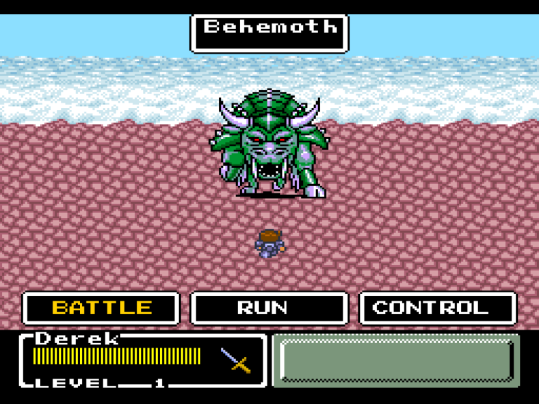
Mass appeal
From the above quote, we can guess that Final Fantasy V’s fate might have been determined by focus groups. Before I even sat down to write this retrospective, the feeling I had while playing Mystic Quest was ‘this is a focus grouped Final Fantasy.’ It’s nice to have the lead localizer sort of confirm that there might have been a little truth to that. The original plan for Final Fantasy V would have seen it released as a spin-off title of some sort, but I will get more into what they did with V later (Spoiler: not release it in America at all until the next console generation.)
Mystic Quest would release in North America just two months before the Japanese release of Final Fantasy V. It would later go on to release in Japan as Final Fantasy USA: Mystic Quest in September of 1993. Final Fantasy VI was released in April of 1994, so expectations probably weren’t too high for the spin-off title in Japan.
The first time I saw MQ was as a middle schooler. I wasn’t terribly interested in playing it, I was too hyper-fixated on the PS1 Final Fantasy games I could not play for myself at the time, and for some reason a shard stuck in my mind that correlated Final Fantasy II (IV) with it. So for a long time I knew the first four mainline Final Fantasy titles North America got as: Final Fantasy, Final Fantasy II: Mystic Quest, Final Fantasy III and Final Fantasy VII. The 90s were a different, more confusing time.
In discussing how Mystic Quest differs from your standard Final Fantasy, let’s explore the focus group idea a little bit. Allow me to pretend to give feedback to SquareSoft as a non-RPG playing fella on Final Fantasy IV and talk about how these concerns were addressed. Remember: Square wants Final Fantasy and role playing games to be a massive hit in North America. They want what Enix had with Dragon Quest where Japanese police officers beg them not to release the game during the school week. Final Fantasy definitely had a host of hardcore fans in North America, but an absolute mainstream fervor would not encompass the west until Final Fantasy VII’s release.
“Five is a lot of party members, I can’t keep track of all this stuff!”
Mystic Quest trims your party down to only two characters and if you so choose, you only need to control one character. The game defaults to your secondary character acting automatically, though you can press a button to change to manual commands. MQ also utilizes the Final Fantasy II and IV approach of having characters constantly entering and exiting your party. The secondary character is always a fair deal stronger than your main character when they show up but by the time they leave, your protagonist should be equal to or greater than them. It’s an easy way to determine whether someone is going to leave your party soon or not. Are you their level? If so, prepare to say goodbye!
I find that if you play on auto, the computer will cheat for you. At some point I switched to auto mode because I wanted to move this along. The combat system isn’t terribly deep with two people so the battle-to-battle strategic decisions didn’t matter so much. I would notice on certain turns that sometimes my main character would get hit with a big critical by an enemy and then my partner would heal me back up before it became time to input moves again. My character gets stoned – no I do not know a better way to word this – and my partner would cast heal. In manual, I would have had to plan ahead for that. I guess they try to give you every leg up that they can?
There were a couple of times later on I had to switch back to manual combat for my partner to do something specific, but it was very seldom.
As a result of having only two party members, battles don’t have a lot of strategy. Towards the end of the game, some encounters will feature minor hurdles with enemies that will reflect your magic or give you a status effect if you attack them physically, but outside of that most encounters feel the same. The only real differences come down to the sprites. You either both attack or one of you heals. There are status effects to manage but there’s no buffs or nerfs. It’s very straightforward.
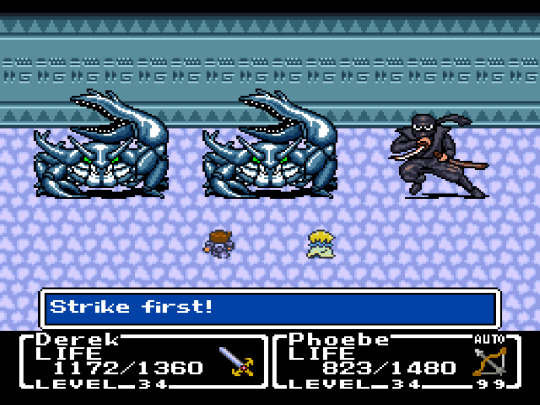
“This ATB system is so hard to figure out. I was browsing that old guy’s spells looking for meteor and some random bad guy called Red Eye swooped in and killed me while I was looking!”
True turn-based gameplay is back. So if you were getting sick of holding it in while you wait for battles to play out, you can once again tell your main character to act and then run out to the bathroom while everyone takes their turn. Given that you only have to put in your main protagonist’s commands if you’re on auto battle, this can lead to some very repetitive encounters. For a large portion of the game, I was just having my two characters attack. I know I said in my FF1-3 recaps that I spend most of my battles just physically attacking but at least there were four party members to choose from. Like if I wanted to attack enemies in other ways, I definitely had options. It felt a little more in depth.
“What’s the deal with all these status effects? How do I cure them? What’s the difference between confused and charmed?”
Status effects remain, but dealing with them is a little simpler than it was in the past. Up to this point, each status effect could be cured with a specific item. There was also the ‘cure all’ item, remedy. These are usually rare and expensive, so it encouraged the player to only use those in emergencies. Better yet, use Esuna! Forget items!
In MQ, there is only one item that heals status effects. It is pretty easily obtained and ensures that status effects will never really hamper your playtime unless you just outright ignore them for some reason. Which you can certainly do because I tackled the first major dungeon of the game poisoned for at least 3/4 of it. Your rotating secondary party member almost always has some white magic, so they’ll usually be able to heal you too. And if they can’t heal you, they’ll probably have the Life spell which will revive you. They also very generously make Life the equivalent to Full Life in Final Fantasy IV, i.e. you respawn with full health.
I will say that with two party members, encountering enemies that throw around status effects willy nilly can be slightly frustrating. There were a couple of times where both my party members were confused or asleep or something and I had to wait for the enemy AI to smack me before I could do anything. I also had a couple of unlucky battles where both of my fellas would get stoned right away, which is an instant game over. It doesn’t happen enough to be annoying but it does happen. Generally if you heal status effects as they come, it’s no big deal.
“Why are there so many spells? How do I know which one to use? Is Fire 2 better than Blizzard 2? Why does Fire need a sequel? It takes me forever to see my spells!”
Your total spell count is really low. Observe.
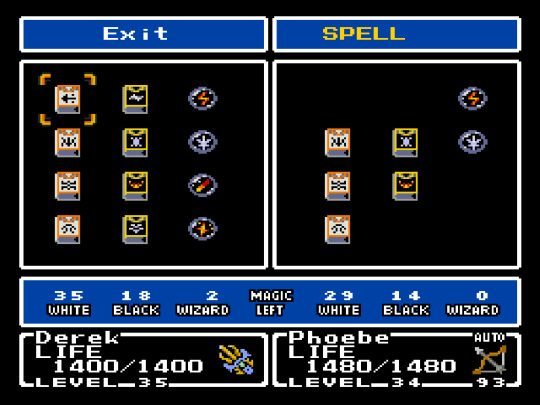
The spell book on the left is the main character’s magic and those 12 spells represent your entire catalogue. You have four white magic spells, four black magic spells and four wizard spells. For white magic you get Cure, Heal, Exit (for leaving dungeons) and Life. Black magic gets Quake, Fire, Blizzard and Aero. Wizard magic gets Thunder, White (holy, or as Kingdom Hearts fans know it as, Pearl), Meteor and Flare.
First, as you can see the magic charge system is back for some reason. I don’t understand the logic behind it because it’s far less user friendly than MP but whatever, maybe they were operating under the assumption that Americans were scared of big numbers not tied to their health pool. The game defaults to having a lifebar instead of HP numbers, you have to opt in to seeing more precise health statistics. Second, the limited number of spells really lowers the number of strategies you can use in battle. No buffs, no debuffs, just the basics on white magic. Black magic? In what could be described as a series tradition at this point (not counting IV), black magic isn’t very useful. There are some enemies with elemental weakness out there, but usually you can just hit them every bit as hard as you can magic them. It’s also really weird that the first spell you locate (we’re back to finding our spells, the main character can’t learn anything) is quake. Quake! That’s endgame shit! Well, not here, but you know what I mean. But there is another reason black magic isn’t useful.
Wizard spells just eat their lunch. It’s black magic but good. I have no idea why thunder was upgraded to a wizard spell away from its blizzard and fire brothers but good for it I guess. If you’re ever in an argument over which basic magic spell is the best one, I guess you can just point to Mystic Quest. Every single wizard spell hits hard. Yes, you have fewer magic charges for those, but they can get you through battles very quickly.
Now you might be thinking having fewer magic charges for wizard spells helps balance things. You might feel desperate enough to actually use quake or something! But no, because…
“This item conservation business is hard work. I run out of MP or mana or magic or whatever weird thing halfway through a dungeon and it sucks. Why can’t I just buy ethers easily? Rydia should be able to nuke at will. Also why are there like eight different potions? What’s the difference?”
MQ offers you the ability to purchase MP restorative items called seeds. Seeds are fairly cheap for how effective they are. You only need to spend something like 25GP to get one and there really isn’t much to spend your money on so it’s pretty easy to get a whole horde of them to carry you through the majority of the game.
By the time I unlocked White, which was immediately my best spell by a country mile because it targets every enemy and hits them for a respectable amount of damage, I basically exclusively used that ability. There was no reason not to because why would I conserve? Yeah I only had like four wizard spell charges but the second I run out, I can just pop some seeds and go right back to town. It makes battles go blazingly fast but it just lowers the already low difficulty level. I am not kidding when I say I barely used black magic. I do not think I ever ran out of black magic charges. Wizard charges though? Wewie brother, I was popping those seeds like mad to keep it up. I think by the end of the game I had eight charges, which felt luxurious. I could make it through eight battles without opening the item menu!
There are other consumable items, but just like with seeds, you don’t ever have to second guess using them. You only have one type of potion that cures something like 300 HP. They are littered all over the map and you can also buy them. You get bombs and arrows but around every other corner there is a treasure chest that contains 10 bombs or a merchant that will sell you a bomb for 10 GP. It’s so wild going from playing Final Fantasy I, a game that demands the player horde their items like some sorta dragon, to playing MQ, a game where you have such an embarrassment of riches that tossing out an item here or there just doesn’t matter. Nothing matters! Why I could say this is a commentary on the haves and have-nots in society but I don’t have enough brain power to activate a think piece like that.
“I keep getting lost. I don’t know where Mysidia or Myst or Riven or whatever is and it’s seriously driving me insane.”
The world map as you know it is completely gone. Instead, you get what looks like a Super Mario World map.
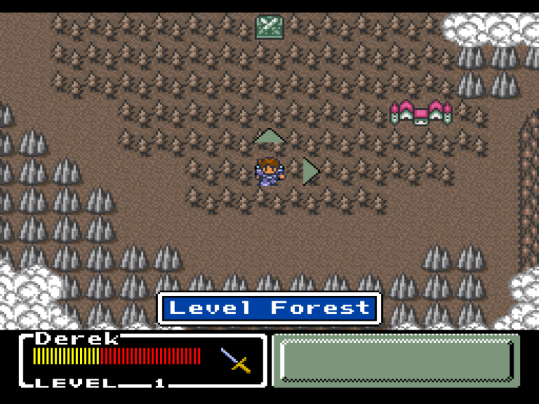
You just guide your little protagonist to the next area and go from there. You usually go to a town and talk to a bunch of NPCs and one of them will say something like “hey bro, go to the bone yard to get the earth crystal” and then a new map will open up for you to explore and you go from there. There’s no fear of getting lost or deciphering NPC dialogue to determine where certain towns are. I mean, as someone who gets lost all the time in real and fictional life, I certainly appreciate that there are people looking out for me. But this format really hampers this era of Final Fantasy where world exploration really feels like it’s part of the experience. A map of this style wouldn’t come around again until Final Fantasy X and X-2, where I feel it’s handled a lot better for what those games are going for.
Part of the leveling process of old Final Fantasy titles was running into random battles while you desperately searched for where to go next. Since that’s no longer the case, Square implemented 10 encounter long “battlefields” throughout the map. You just fight 10 battles, one at a time, and at the end you get an award…sometimes. Other times it’s just a bunch of EXP. So if you ever feel underleveled, just do those. I did them all because I hate myself and try to do every objective that comes across as long as it’s reasonable, but the average person can just skip these. I do not see ‘being underleveled’ as a problem many people will have with this game.
Probably the strangest part of this title is when at the very end you need to backtrack for an item called the Thunder Rock. Since you don’t need to get into an airship to fly to a different part of the world, you just move your character across the map city by city until you get to where you need to go. Then you go into the city, talk to the NPC, and then go back. There isn’t a boss battle, the NPC doesn’t give you any narrative, there’s no trick – you just get your item and that’s that. It takes like five minutes and I can’t understand the purpose of it. It’s like in a modern game when you need to flip a power switch but oh no! The power is out! You need to flow power to it in order for the switch to work! It just comes across as pointless padding.

“I never know when I’m going to get into a battle. Cecil will just be walking around and POW I’m in a fight. That’s so annoying, I’m just trying to become a Paladin.”
For the first time in the franchise, random battles are completely gone. Instead, you just see enemies on the world map. They are always in the same spot no matter what you do and they will always reload if you exit the dungeon or whatever you’re doing, but you can avoid excessive battles if you want to. Even though the implementation of encounters is kind of basic and makes the world feel very artificially created, it’s still nice to see this in a SNES Square game. They would later go on to do this better in Super Mario RPG. Really if you look at the basics of how this game operates and then compare it to Super Mario RPG, it’s very similar. One is just way better and actually did convince people to try this strange turn-based genre and the other is Mystic Quest.
For mainline Final Fantasy titles, non random encounters would not appear for quite a while. I don’t count XI in this because an MMO with random encounters seems absurd, so the first single player game you see this in is Final Fantasy XII. Encounters have been not-so-random since then. It’s interesting that they kept that staple of the franchise in for so long since other Square games like the aforementioned Mario RPG and Chrono Cross both ditched them.
“Why are there so many weapons here? Should Cecil use a sword? A bow? No weapons? It’s a little overwhelming.”
Early Final Fantasy games were pretty lenient with what they would allow your characters to use. With I and III it makes a lot of sense because those characters are just avatars for the player, but II and IV were pretty loose with it too. If you’re more familiar with later games in the franchise, you’ll know that they eventually migrated to a system where each character has a weapon dedicated to them. You can’t have Squall equip one of Quistis’s whips for example.
Mystic Quest dumbs this down to the point of just removing the ability to equip things entirely. Yes, you will find new weapons and armor, but they will just stack onto your character and replace what they had beforehand. If you get a sword upgrade, you can’t switch back to the old sword. You just have your new blade. Going to the equipment screen is just for reference. Your character has access to four weapons (sword, axe, a grappling hook-like thing and a bomb) and you can switch between them as much as you like by pressing R and L. In old Final Fantasy titles, flying enemies were often weak to bows but not very many other enemies had weaknesses related to physical attacks. That is not quite the case here, with multiple enemies having weaknesses to your various weapons. I would like to think this is to make up for how shallow the magic system is.
To me, the way this works comes across like an old Zelda game. I’m thinking Link’s Awakening here. You get your seashells and then you get your fancy new sword and the old one just vanishes. That works pretty well for a more action-focused game but in a turn-based RPG, I think it takes some of the player agency away. What if I wanted to have a challenge run and equip really weak items? I guess you could just avoid all treasure chests if you really wanted to but…oh who am I kidding, who the heck would try a challenge run of Mystic Quest?
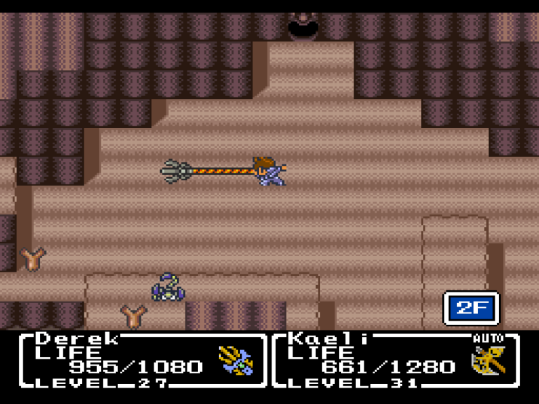
“The overworld is so boring. All you can do is walk and talk to people. You can’t even swing your sword out there!”
Speaking of Zelda, I feel this part of Mystic Quest was probably designed with games like Zelda in mind. In the overworld, your character can take various actions. You can swing your sword or axe, you can blow up certain rock or bone formations with your bombs or you can use your grappling hook-like-thing to climb up walls. You can also jump! This leads to some dungeons having some very light puzzle elements. Combined with how massive some of these places are – seriously the dungeons here are about as long as Final Fantasy II’s and definitely longer than most of IV’s – you have some really annoying levels.
My least favorite was probably the ice temple. This might have been my emulator legal SNES playing tricks on me, but this was the one place in the game where random encounters were turned back on. Enemies were still stationary but I couldn’t see them, so it felt like an older game. That dungeon was like a giant maze where you had to jump carefully over things, fall down multiple floors and flick switches with your sword to open new paths. Combining that with the non-random battles, it was probably the most miserable I have felt playing one of these games so far. I was trying to figure out where the hell to go and then every fifth step I’d have to fight some battle and it’d really break the flow of things.
The jumping thing leads to some really unfun positioning puzzles that require you to leave the area and come back in some way. They aren’t hard by any means, but with the glacially slow walking speed it sure is annoying putting blocks in the right place. This game would have been a lot more tolerable if it kept things simple. But hey, it’s neat that jumping made its debut here. The next Final Fantasy title to try that was X-2 and it was in very limited quantities. You couldn’t jump on will until XV. No, MMOs do not count.

“This story is too wacky. Some moon guy hypnotized some guy named Golbez and also Golbez is your brother? A little kid fell into some weird dimension and aged into an adult? What the fuck is a Namingway? Also those fakeout deaths had me sweating.”
MQ is like a meeting ground between NES-style Final Fantasy storytelling and the FFIV style. The overall narrative is very straight forward – the crystals have been shut off and the world is fucked and you need to fix everything. You go to four distinct areas and fight your new version of the four fiends and then you find out the true master behind it all and deal with him. NPCs have more dialogue here than they do in the older games, but it’s more flavor text than anything.
You don’t actually learn anything about your character though, he’s just a plucky brave kid trying to save the day. There are no character arcs to be seen here, but your entire cast is still well more defined than the main cast of II I suppose. It’s not bad or anything like that, it’s just exceptionally dull. It feels like a giant step backwards from Final Fantasy IV.
Now you might remember IV had a lot of fakeout deaths. I would like to think this was based on feedback from Final Fantasy II, but whatever. Some characters are gone for hours of game time only to pop back later.
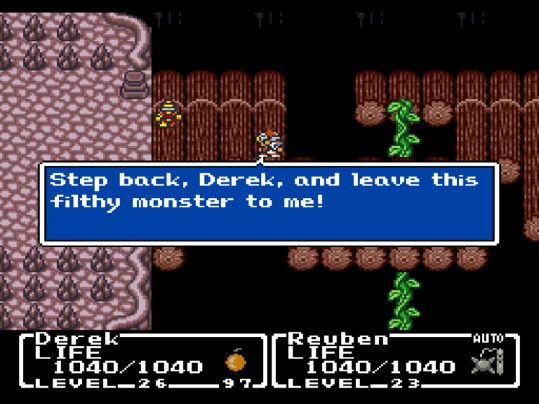
Here, there is exactly one time a character is seen to be in mortal danger. You’re walking along a bridge and some bad guys attack you. Your party member of the hour, Reuben, bravely sacrifices himself so you can escape. You aren’t even allowed to think he’s dead for a millisecond as the screen pans down so he can assure your protagonist that he’s okay and you just move on. Come on Reuben, the enemies in this area were kinda weak, I probably could have just cast White and finished them! There was no need for that kind of bravery!
“So if I lose and I didn’t save, that’s it? I lost hours of progress?”
Here is what the game over screen of Mystic Quest looks like:

If you click no, it just restarts the battle from the beginning. It’s a convenient feature because you will waltz your way into an accidental death or two, but it makes marching into any battle feel bereft of consequences. Going into battle and just mashing on the A-button over and over again will usually get the job done anyway, but if you blindly do it and get yourself killed, it’s cool. Just try again.
I think retries are fine. It’s just that this game is already so devoid of challenge that placing a little player inconvenience there wouldn’t really hurt. You can already save whenever you want, so even if you did die to a random battle, odds are you wouldn’t lose a whole lot of progress. Still, a feature like this is console generations ahead of its time. Very few games just send you back to the title screen anymore. It’s just a little weird to see such convenience in a 90s RPG for the SNES.

“That music sure kicks ass”
You’re damn right it does and I can say that Mystic Quest also has an excellent soundtrack. The main composer credited is Ryuji Sasai and he turns in a performance that is different from what you’d hear from Nobuo Uematsu, but is still one that you won’t want to mute.
youtube
I’ve mentioned the walking speed very briefly before, but let me reiterate: it’s slow. Like, heinously so, to the point that I think most players would probably drop this game without utlizing an emulator’s fast forward function. If this game had a bad soundtrack, I truly believe most people would bail in order to play something a little more fast paced. The music here truly carries MQ and in some ways saves it. This is a game almost nobody talks about anymore and yet it earned a place in the most recent Theatrythm (Final Fantasy rhythm game) title. That’s impressive! I don’t think it’s a top-tier Final Fantasy OST by any means but it could have been so much worse. Like, have you played Sonic Chronicles: The Dark Brotherhood? …If not, please don’t.
While I may have come off as slightly harsh on this game, please understand that there are things I do like about it. It’s not one of the worst games ever made, or even close to it really, but it’s painfully boring and slow. It feels like a weird missing link between the Famicom titles and Final Fantasy IV, even though it was released AFTER IV came out. The cover art does say “Entry-Level Role Playing Adventure” so I guess they do try to warn you a little bit.
Notable characters
For the playable characters, this title does not include character portraits like the mainline games do. So I grabbed character portraits from the instruction manual (thanks to the Final Fantasy wiki) so you could get an idea as to what your heroes are supposed to look like. The chibified character art is pretty common in the series up to this point, as seen in the Super Famicom cover for Final Fantasy IV.

I like that the art style can at least be tied to the original series.
Protagonist

Here is the very first screen you are greeted with in Final Fantasy: Mystic Quest
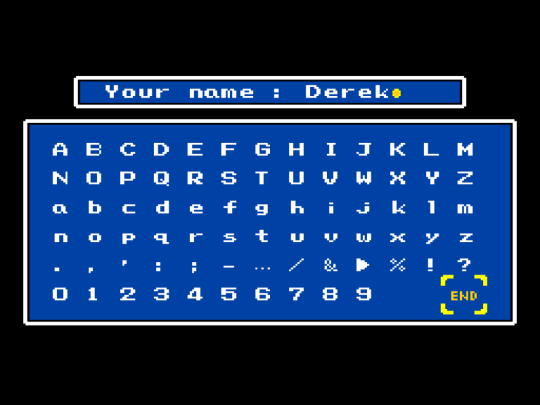
It starts out totally blank, implying that there is no true name for this fella. However, if you open the instruction manual, you will find out that his name is Benjamin. Very cool. I decided to just name him after myself, like any good middle schooler would do. “Benjamin” is the only character in the game that you get to name. So if you wanted a group of you and your best bros to take on the Dark King, well, too bad. I have referred to him as ‘the protagonist’ up to this point in this retrospective, so I will continue to do so. Though if I accidentally call him Benjamin, Benny, Ben or Benmothy…I apologize.
The journey starts with your main character’s village getting destroyed by an earthquake. A mysterious old man shows up and tells him that this is because a group of villains called the “Vile Four” stole the power of the crystals and locked up the Focus Tower, which is at the center of the world and basically brings everyone together.
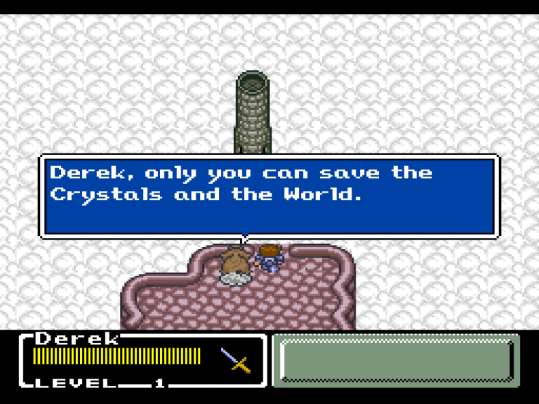
The old man says that there is a prophecy that states a hero will show up and save the world and wouldn’t you know it, the old fella thinks you’re that hero. Exciting!
The protagonist is the only character you have complete control of for the entire game and yet he spends a lot of the game being outclassed by your other party members because they always join like five-or-so levels above what your protagonist currently is. This changes in the late game when your protagonist has the best magic, but until that point your buddies will often be more useful than you are. Some legendary hero! I guess he’s by far the most useful character by the end of things, so it all works out.
Kaeli

Early on in the game, the protagonist travels to the Level Forest – a bad name for one of the first areas in the game, made me think the fire area would be called Level Lava or something – and discovers it is in bad shape. He takes a withered branch and presents it to Kaeli who is something of a nature lover and vows to go to the forest and help you fix it. It’s unveiled that an evil minotaur is poisoning everything in the vicinity and he also poisons Kaeli, but that doesn’t stop her from helping you send the Minotaur packing to save the forest. She still collapses from all this and your main character must now focus on saving her! Wouldn’t you know it though, the cure for her illness is in the BONE DUNGEON which is also where your first crystal is. How about that! Her illness leads to one of my favorite exchanges in the game.
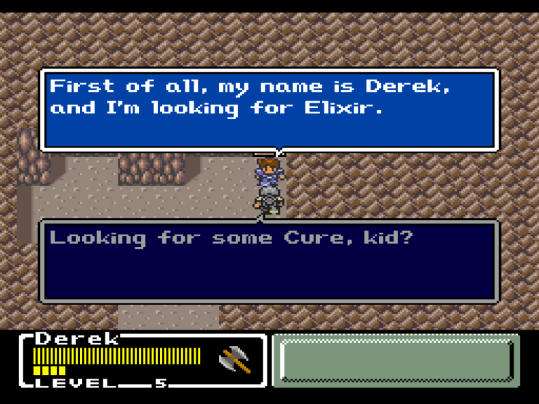
It gives me some serious “LOOK MOM IT’S A DIGIMON, IT’S NOT A POKEMON, THEY ARE DIFFERENT.”
Kaeli’s defining combat characteristic is that she has an axe. It makes her very useful against creatures of the forest, like evil trees, because they are weak to axes. She comes back later in the game with an even better axe to use against even more evil trees. Heck, you enter a giant tree during her return to root out the evil in th…wait a minute, did Ocarina of Time steal from Mystic Quest!?
I think they hint a couple of times about her having romantic feelings towards the protagonist, but I might have been trying to find a character where there wasn’t one.
Tristam

Your mandatory ninja companion! You meet him while trying to save Kaeli and he agrees to let you have the elixir if you help him clear out the BONE DUNGEON. This works out because, as I said, the earth crystal is there. He sells you explosives once you get there, which will go on to become one of the most important items in the game.
When you get your single fake death in the game, Tristam rejoins you very briefly. Like 20 minutes later you run into another character who says he might have found a treasure somewhere and Tristam immediately takes him at his word and fucks off for the rest of the game. Well until the credits. I had a good laugh at him leaving you at the mere suggestion of treasure though. Maybe this fella was inspiration for everybody’s favorite Final Fantasy ninja, Yuffie Kisaragi.
Tristam uses ninja stars, which are not an infinite resource. I never ever came close to running out of ninja stars so I don’t know what happens if you ever do, but the number ticks down every time you attack so I figure it’s worth noting. He teases you early on with a grappling hook only to just give you one for free later on, which is very nice of him.
Tristam is probably in your party less than any other character in the game and that probably makes him my favorite one. As they say, absence makes the heart grow fonder!
Phoebe
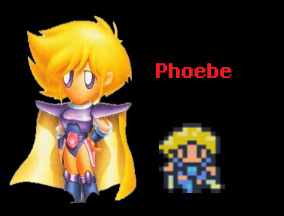
You meet Phoebe while you are trying to find your second crystal. Her hometown, Aquaria, has been frozen over because the water temple has been taken over by an evil Ice Golem in the Ice Pyramid. Killing the golem frees Aquaria. Phoebe is the character you probably have in your party the most, simply because she is your companion for the final boss of the game, the Dark King. You’d think it would give her more of a character, but no. The only thing you need to know about Phoebe is that she loves her town and that her grandfather likes to dig a lot.
From a gameplay perspective, Phoebe hits really hard with her arrows and has the highest magic stats in the game. She has access to a wizard spell in thunder, which is extremely useful when you recruit her. During the final stretch of the game, she gets access to the White spell and has 10 wizard charges which is really nice. But for me, she was basically just around to heal the protagonist if he got put under a status effect or something. He has access to more powerful skills, so even if his magic stats are technically weaker, he still is more valuable than Phoebe because Phoebe can’t cast flare.
She’s also your partner during the most annoying part of the game, which most definitely put her in a negative light in my eyes. I cannot stress how much I hated the Ice Pyramid.
Reuben

Your final party member! Hey you make four friends and the main bad guys are called “The Vile Four.” Do you think there’s a correlation there? Who can say. You meet Reuben when you’re trying to find the fire crystal. He tells you his dad knows where it is, but his dad is trapped behind a boulder somewhere and he needs your help to save him! So everyone wins by this alliance. Reuben is the first party member you get who doesn’t seem like he wants to ditch you, so the game invents a reason for him to ditch you by giving him the half-a-second fakeout death I mentioned above. How rude. He comes back later to help you reach the final dungeon but quickly leaves again.
Reuben hits really hard but his magic skills aren’t terribly useful. The first time you get access to him, the only spell he knows is Life. Life is handy in case an emergency happens, but it’s not something you would get a use out of in every encounter. He returns with White much later on, but much like Phoebe, by the time he returns to the protagonist, your main character is just too strong. He’s there to support and keep ya moving. By the end of the game, I was pretty ready for it to be over so maybe I’m being unfair to these guys, but if the protagonist can solo most everything so efficiently, why would I shake things up?
Spencer

When grabbing screens for this game, I forgot to grab some for characters I thought were important. Every single stinking picture of Spencer I have in my FINAL FANTASY: MYSTIC QUEST folder is from a side profile, the end of the game with the entire main cast that would be really weird to use here or from the back like this. So I went ahead and attached my favorite Spencer screen and just hastily placed front-facing Spencer on there. There might be one or two more guys I do this with. Plus I just love this dialogue exchange because Spencer just likes digging. Dudes rock, ya know?
Spencer is Phoebe’s grandfather. He is trying to dig a tunnel from underneath Phoebe’s hometown of Aquaria all the way to a lake where another important character, Captain Mac, is trapped. The goal of this is to get Aquaria’s water into the dried lake where Mac is stuck. A one man digging operation seems like the most efficient way to do this, sure. Unfortunately Aquaria is frozen over when you reach that area and Spencer is trapped down in his little tunnel. Not to worry, his plight is why Phoebe joins your party, so his suffering is your gain. When Spencer gets free, our good friend Tristam lures him away from his work with the promise of a treasure hunt. He bails and then in the best scene of the whole game, Phoebe gets frustrated and throws a bomb in an effort to complete the tunnel really quickly but this fails and just destroys this guy’s hard work.
Despite not really needing his zany tunnel anymore, he goes back to it at the end of the game to continue digging. Even though Spencer doesn’t get a ton of dialogue, he came across as a crazy old coot (kinda like FFIV’s take on Cid) to me and I found him very charming.
Arion

This Indiana Jones looking guy is Arion. He is Reuben’s father and a major reason why that particular rapscallion joins your party. Just like with Spencer, the crystals going haywire has trapped him somewhere. In Arion’s case, he’s trapped behind a boulder that can only be destroyed by mega grenades (an upgrade for your bombs that Tristam so nicely hooked you up with). Once you save him, he just tells you where the Fire Crystal is, which allows you to finish up your journey through the fire nation.
Arion is also the NPC that you have to visit for that garbage fetch quest I mentioned above regarding the thunder rock, so I am inclined to dislike him a little bit.
Otto

This guy’s full name is apparently Otto CID Bekenstein. That’s right, even Mystic Quest has a Cid! Now I didn’t encounter this anywhere in the game myself, but I read it online and I choose to believe it. It also makes sense because Cid is a mechanic which falls in line with every single incarnation of Cid ever up until this point.
Otto operates a machine that generates a rainbow road, which would help the party get to the wind crystal that is located in Pazuzu’s tower and doubles as a sick go-kart track. Pazuzu is one of the Vile Four, for the record. His daughter just so happens to be trapped there too, but unfortunately there is a lot of wind disturbance going around and his machine is broken so he tasks your crew with fixing that and then saving his daughter. He’s also involved with the thunder stone fetch quest I mentioned earlier, so I can’t say that I’m a fan.
Since this is the last time I’ll mention it, I’ll just explain it real quick. The thunder stone is used to power up the rainbow bridge machine so that the bridge extends to Spencer’s zany tunnel, which allows your party to get to Captain Mac and his boat, which then allows you to get to the end of the game. Cool? Cool.
Captain Mac

Mac is Kaeli’s father and goes on an expedition at the start of the game to learn more about the prophecy that states a warrior will take down the Vile Four and restore the crystals. Unfortunately while he is sailing, crystal shenanigans occur and his boat is stranded in a dry lake. Using the powered up rainbow machine, your protagonist proceeds to set off another bomb in Spencer’s place which floods the lake Mac’s boat is stuck in. Whenever you reach the captain, he informs you that there was more to the prophecy than anybody realized. He states that the true fiend behind this is someone who is commanding the Vile Four: The Dark King. You then can take his boat, head to Focus Tower and finish the game.
Mac is strange because I feel like the game talks a lot about him before he shows up, but when looking over my notes while writing this section, I have towards the end “I still don’t really know who Mac is.” He’s important because he unveils the mastermind of everything, but I’m not sure how everybody in the world knows who he is or why Spencer is trying desperately to save him. I guess all we need to know is 1. he’s an explorer 2. he’s Kaeli’s dad 3. he has found some neat information and 4. he gives you his boat.
White or "Mysterious old guy"
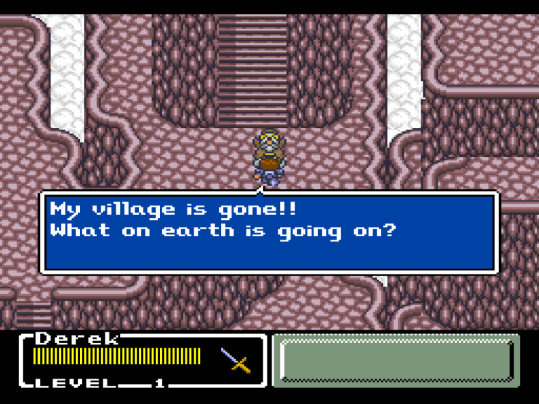
Throughout your journey to save the crystals and the world, a weird old guy will pop in and give you vague information and then go away. He seems to know a lot about the workings of this world and he shows up a lot to sort of guide you along. You might even briefly think that he knows too much, but at the end of the game the nature of the mysterious old man is revealed.
He’s a crystal! Like, you know, one of the tentpoles of the franchise at this point? Kind of an interesting idea for a character reveal because it makes sense that a crystal would be interested in saving the crystals, but I wish this idea had been explored in a Final Fantasy game that actually has an interesting narrative. Wait…I activated and rescued all four crystals. How could he contact me while deactivat-
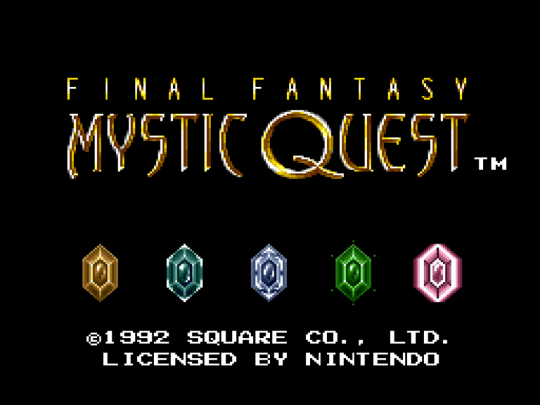
The title screen hinted at this. Five crystals! It’s right there! Well played.
The Vile Four
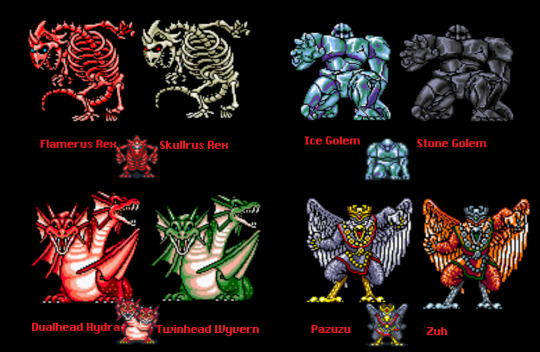
The Four Fiends return again and just like in the Famicom titles, they even come back from the dead at the very end of the game as part of a little boss gauntlet during the final dungeon. In the above compilation, the original bad guy is on the left while the revived one is on the right. The little fella in the middle is the overworld sprite of the original encounter. The final dungeon is probably my favorite dungeon of the game because it reminds me of Hyrule Castle in Ocarina of Time. What I mean by that is it’s comprised of tiny bite-size portions of the major dungeons you’ve encountered so far. This part of the game is pretty straight forward, so even the annoying ice pyramid isn’t so bad when it only lasts two screens. I’m just a sucker for when a game puts you through a microcosm of itself. It’s a trip down memory lane!
As for the boss fights themselves? They all kind of run together. The only one that requires any strategy is Pazuzu because there is a brief period during battle where he will counter your magic abilities. It is one of the few times the game outright forces you to ‘strategize’ so it stands out. The rest are just ‘cast a big spell and heal’ so I will take what I can get.
The Dark King
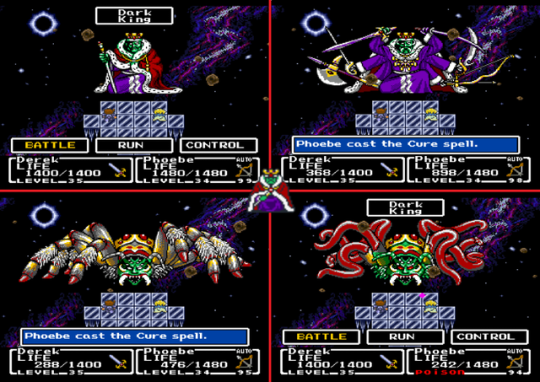
Here’s the final boss of the game. He’s the only baddie in MQ with multiple forms. He has four of them and in the little grid above they are ordered clockwise starting in the top left. There doesn’t seem to be any differences in the four forms as far as combat goes, so just look at it as a way to tell your progression. My favorite one is his second form because he looks like a poor man’s Gilgamesh from other Final Fantasy titles. Just like every other non-Pazuzu boss, all you need to do is hit him hard and heal and you’ll be fine. Somehow he is harder than the final boss of Final Fantasy II, but to be fair I used a blood sword when dealing with that boss so I might have had an unfair advantage.
As our good friend Captain Mac told us, the Dark King is the one behind everything. He’s the key to all of this. He has basically no personality outside of “boss of the bad guys.” It’s not quite a Necron situation because you’re explicitly told he’s the main bad guy by Mac before the final dungeon even starts and wait shouldn’t White have told you about him? He should know about this guy! Oh whatever. He’s evil and you need to kill him. Simple as that.
It started here
I’m not going to pretend later Final Fantasy games pilfered ideas from Mystic Quest, but I still wanted to point a couple of things out. Think of these as an early cameo.
No overworld, retries instead of a game over
Both mentioned above. The no overworld thing is interesting because every mainline Final Fantasy title would have one until Final Fantasy X. Then they just kinda vanish until Final Fantasy XV. That’s not to say other SquareSoft titles evaded an overworld, the other beginner friendly Square title Super Mario RPG also chose to go with a level select screen, but it’s definitely interesting to see a SNES title with Final Fantasy branding just not have that.
Battle damage
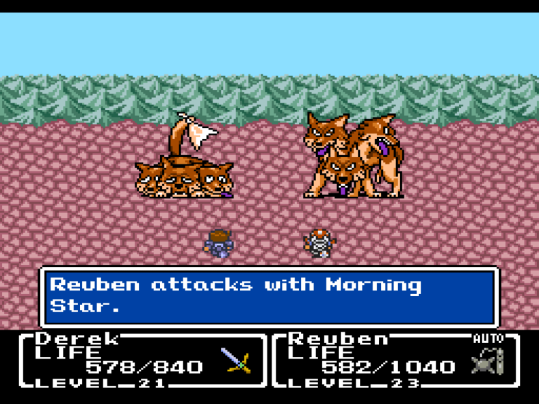
I would like to think focus groups were bothered by how you just can’t tell how much health random enemies have (without casting magic that explicitly tells you), so their solution to this problem was having enemies have different sprites based on how much health they have. It’s fun when you one-hit a bad guy because their battle damaged form will pop up very briefly before they vanish entirely. It’s actually admirable how they gave every enemy multiple sprites because not even later Final Fantasy games do that, usually the only characters to show a ‘weakened’ state are boss monsters. Going back to Final Fantasy X, a lot of bosses show fatigue when they’re close to going down but I can’t think of a single regular encounter that has enemies acting differently when they’re about to die. Mighta been kinda nice for when you’re fighting Sand worms or a Zu, ya know?
My favorite sprite in the game is the werewolf as seen above (you thought I forgot about that in my character recap? hah!) He’s CLEARLY waving a white flag. He’s surrendering to you! And yet the protagonist must wail away on him anyway to get that sweet EXP. My second favorite is the little Edgehog because it looks like he got a bad haircut. It’s cute.
Bosses have multiple damage sprites, which helps give character to those battles and helps those characters stand out from the rank-and-file. Hey man, the battles themselves aren’t that interesting so they gotta do something, right? The Dark King seems to eschew battle damage to give you forms, which I think is a poor substitution because it just makes the Dark King stand out as the only bad guy in the game who doesn’t show proof of your prowess.
Spin-offs
Now you might try to take me to task by claiming that Final Fantasy Legend or Final Fantasy Adventure count as the first spin-off titles but I disagree. Those were SaGa and Mana games that got rechristened so a North American audience might be willing to try something new. Mystic Quest, from the ground up, was designed to be a Final Fantasy spin-off title. It may not be the greatest game ever, but there are roughly 83,000,000 Final Fantasy spin-off titles now and this is where they start.
Before you ask, no, I’m not going to do retrospectives on every Final Fantasy spin-off game. The only other one I plan on doing right now is Final Fantasy Tactics. I will be doing select sequels (like X-2), but I don’t consider those spin-offs. I chose to recap Mystic Quest because it was the first major spin-off title and it is also what Westerners got instead of Final Fantasy V.
In conclusion
This is likely a game many people wouldn’t even bother with (myself included) if the words FINAL FANTASY were missing from the title. It’s a game that would probably be forgotten to history if it wasn’t for those two simple words. It’s not absolutely horrible by any means, it’s just dull and forgettable. A middling title in a sea of more interesting Super Nintendo games.
I think if Square’s aim was to get Western children into RPGs, this was a bad way to do it. They would eventually figure it out with Super Mario RPG, but I don’t think a playthrough of Mystic Quest would convince anybody to try out Final Fantasy IV or the relatively soon-to-be-released Final Fantasy VI.

#Final Fantasy#Final Fantasy: Mystic Quest#Final Fantasy retrospectives#video games#vidya thoughts#opinion#super nintendo#squaresoft#square enix#retro gaming
1 note
·
View note
Text
tantricCatnip now streaming: Final Fantasy: Mystic Quest
let's get comfy with some retro fun! 💜
tantricCatnip is now streaming: Final Fantasy: Mystic Quest
Current viewers: 3
0 notes
Text

Final Fantasy: Mystic Quest (1992)
876 notes
·
View notes
Text
#final fantasy ix#final fantasy viii#final fantasy iv#final fantasy xiii#final fantasy xii#final fantasy tactics#final fantasy mystic quest#dissidia 012#final fantasy v#dirge of cerberus#world of final fantasy
149 notes
·
View notes
Text



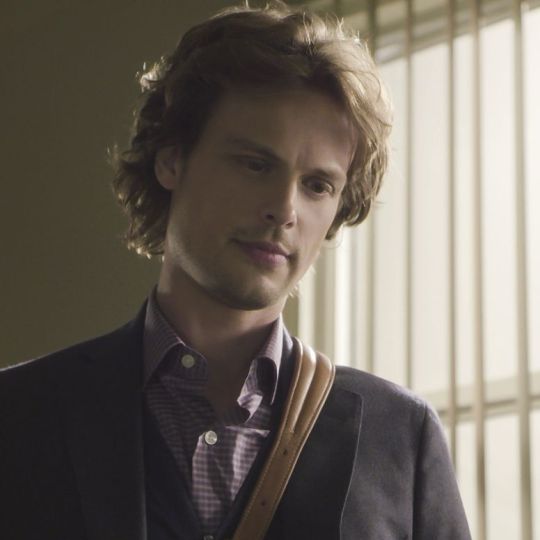

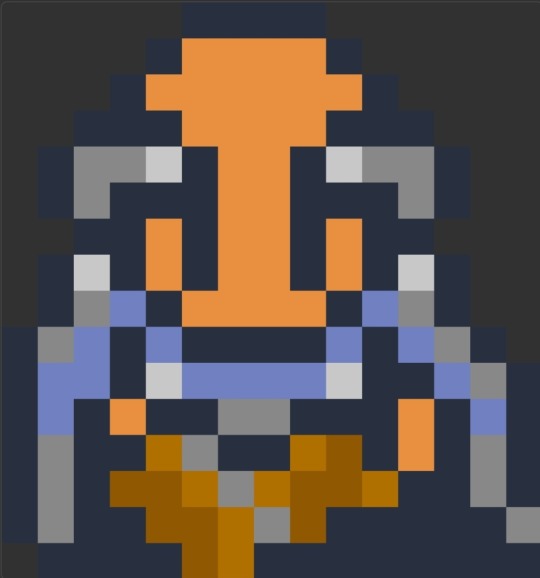
I'm doing a series of "Best Character Named X" polls where all the characters have the same first name but are from completely different media, feel free to send in name/charcacter suggestions, I'm posting one poll a day, check my pinned post for active polls
#best character named x#poll#poll game#spencer hastings#spencer james#spencer shay#spencer reid#spencer balamory#spencer final fantasy mystic quest#pretty little liars#all american#iCarly#criminal minds#balamory#final fantasy mystic quest
60 notes
·
View notes
Photo
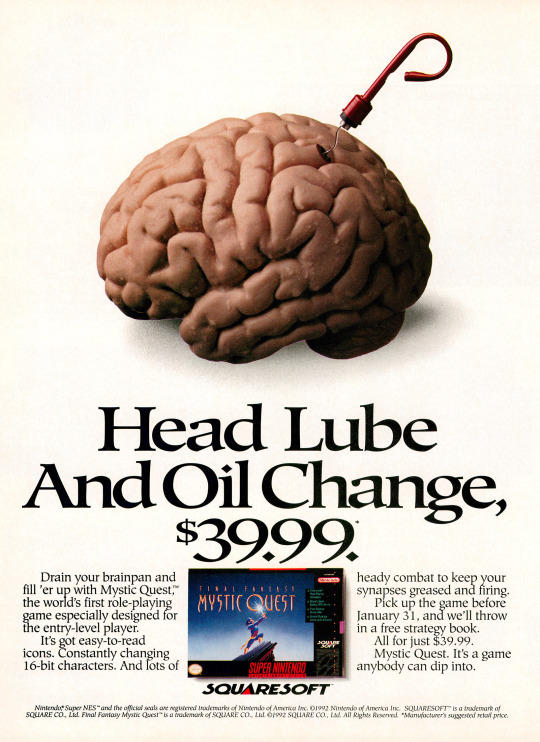
Final Fantasy Mystic Quest
“Head Lube and Oil Change, $39.99” (GamePro #43, Feb. 1993)
112 notes
·
View notes
Video
dancing1
#touhou#mmd#suwako moriya#satori komeiji#koishi komeiji#MTB#Final Fantasy Mystic Quest - City of Fire#video
581 notes
·
View notes
Text
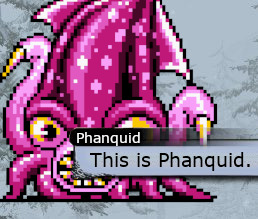
This is Phanquid.
#i spent too much time on this#this is a joke that like four people will get#ff14#final fantasy mystic quest#shitpost#this is thancred
7 notes
·
View notes
Text
Finally got around to playing Final Fantasy Mystic Quest. I'm about...halfway?...through it. /i mean, I dunno, I'm like five hours in but I sure seem like I'm halfway done.
I wouldn't say it's good but it is charming and if you like SNES JRPGs and want to kill 10-15 hours you should go for it.
4 notes
·
View notes
Video
twitch
Now streaming Final Fantasy: Mystic Quest on Twitch!
1 note
·
View note
Text
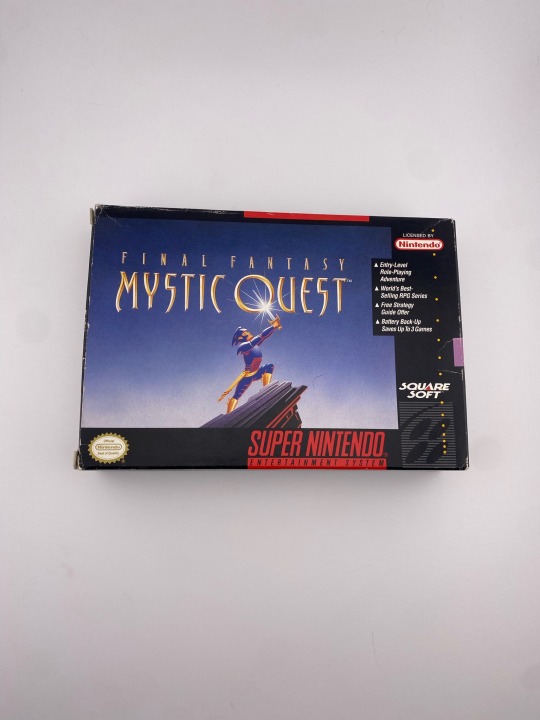
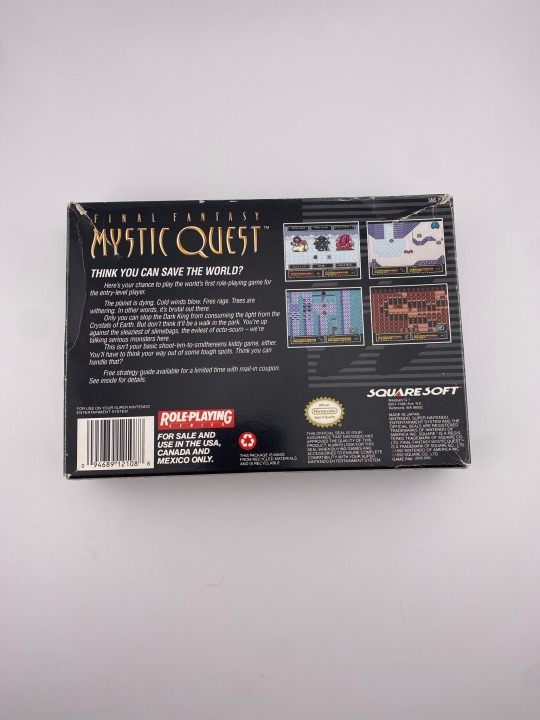
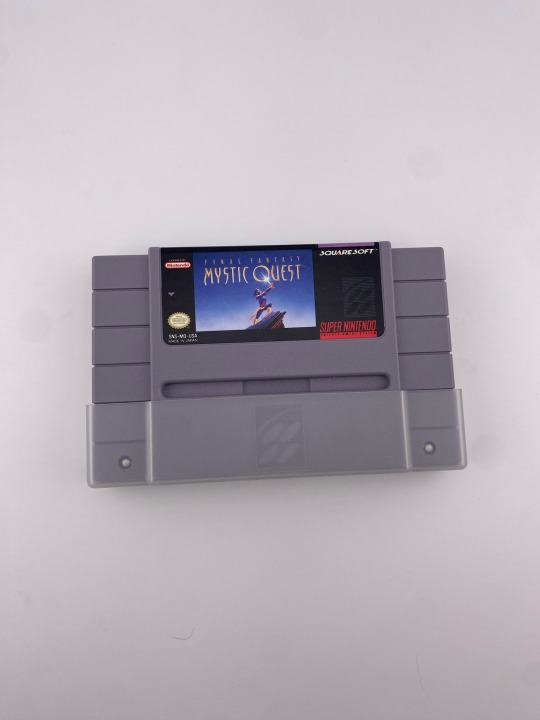

Final Fantasy Mystic Quest was called the RPG intro game and experienced enthusiasts did not like the simplicity at the time. I loved the game and its unique gameplay style when I bought it and now retro gamers are enjoying it moreso than when it released for the SNES in 1992.
It follows the typical story of a journey a young hero is tasked with saving the world from destruction. The narrative is straightforward yet engaging, making it accessible for newcomers to the RPG. Combat is turn-based, with a variety of weapons, spells, and abilities to master. The game also features puzzle-solving elements and a world map to explore.
While not groundbreaking, the graphics are colorful and charming, with detailed character sprites and vibrant environments that capture the essence of the Final Fantasy universe.
The soundtrack is a standout feature, composed by the legendary Nobuo Uematsu. Each track complements the gameplay perfectly, immersing players in the world of Mystic Quest.
#rpg#jrpg#role playing games#final fantasy#final fantasy mystic quest#super nintendo#nintendo#snes#16bit#classic games#classic rpg#retro#retrogaming#retro games#squaresoft#video games#gamer#gaming#retro gaming#twitch streamer#twitch#streamer#pixel art#pixel graphics#nobou o#nobou oematsu#gaming community#nintendo classics#classics
2 notes
·
View notes
Text

Phoebe Mystic Quest I love you forever
#FFMQ#final fantasy mystic quest#ffmq phoebe#final fantasy#mystic quest#phoebe#digital#fanart#2024#Nutmeg art#maybe I should draw Kaeli too it might be fun
3 notes
·
View notes
Text
Okay?
snatches your wig
2 notes
·
View notes
Text
#final fantasy#final fantasy tactics#final fantasy vii#dirge of cerberus#crisis core#final fantasy the spirits within#stranger of paradise#kingsglaive#vagrant story#final fantasy mystic quest#final fantasy crystal chronicles#final fantasy type 0#world of final fantasy#final fantasy tactics advance
200 notes
·
View notes
Text
22 notes
·
View notes